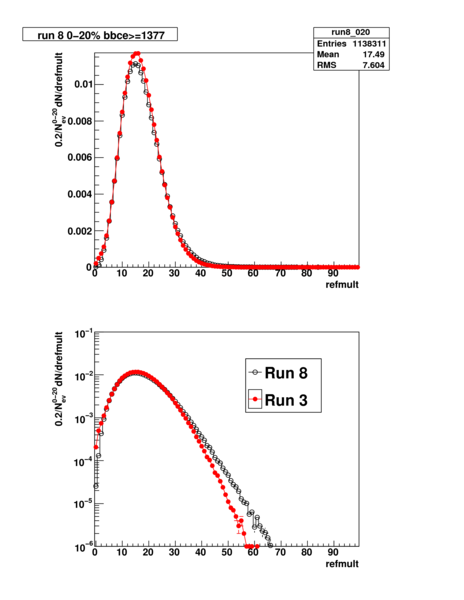First attempt to do Centrality using the BBC in d+Au run 8
Attempt to match the run 3 FTPC and Glauber simulations to run 8 BBC distributions
In d+Au collisions, in run 3 we used the FTPC to select centrality, in order to avoid issues at low multiplicity of selecting events in the same phase space in which we measured. In run 8, the FTPC will need some study, since it had a number of RDO boards out, which changed over time, and it also had serious pileup due to the higher coincidence rate. It is also not available in all events, such as the FMS Fast events. So, I have taken a look at the East BBC, which covers somewhat the same phase space, though in fact is even more farther removed in rapidity from the TPC than the FTPC.
Below is the BBC Adc Sum, East (mu->event()->bbcTriggerDetector().adcSumEast()), plotted as 1/Nev dN/d(BBC^{1/4}) using the rebinning methods of Tom Trainor and Duncan Prindle's centrality paper, hep-ph/0411217. Run 3 is from the STAR published dAu paper, Phys. Rev. Lett. 91 (2003) 072304, data available at http://drupal.star.bnl.gov/STAR/publications/evidence-d-au-measurements-final-state-suppression-high-pt-hadrons-au-au-collisions-rhic
I have attempted to scale up the FTPC distribution by matching the high half-max endpoint between the run 3 FTPC (~2.2) and the run 8 BBC (~6.6), giving a scale factor of 81. I also fudged the overall normalization of the run 8 data to take into account possible inefficiencies or biases. Blue is trigger id 210000, a pure ZDC-east trigger, with the additional requirement of a TPC vertex cut in an attempt to clean up backgrounds, which were there in run 3 and surely are ther in run 8, since a singles trigger in the ZDC is not very selective against background. This may or may not be successful a priori, and surely introduces some inefficiencies in the very peripheral end. Red is trigger id 210020, which is very clean due to a tight VPD timing cut (at |vz|<30 cm), but has some issues in the peripheral end: it is both inefficient and biased, since the resolution of the VPD gets quickly much worse in peripheral collisions. The two effects beat against each other.
With this scaling, the purple (FTPC distribution run 3) and the blue (210000 run 8) match relatively well, at least as a first shot. Using this, we get:
| Centrality | FTPC Run 3 (>=) | BBC Run 8 (>= |
| 0-20% | 17 | 1377 |
| 20-40% | 10 | 810 |
I then looked at Refmult (which is the TPC primary track multiplicity for |eta|<0.5, Nfitpoints>=10) comparing run 8 with these cuts (and 210020 trigger id, abs(vz)<30) and the Run 3 distribution in Figure 2 of arXiv:0808.2041, the submitted long spectra PRC, available at http://www.physics.purdue.edu/~fqwang/protected/Levente_paper/Figures/plots/Fig02b_dAuMult.txt
The comparison looks quite good (except for tails at the percent level) for 0-20%, but progressively worse for 20-40% and 40-100%. One can see a pretty clear cutoff from the 5-track requirement of the Minuit Vertex Finder, and there are also tails to higher multiplicity in run 8 vs. run 3. These may be due to background in the BBC's, misidentified vertices, additional tracks from pileup, etc. In all cases the normalization is to the 0-20% event cut.


.png)
In summary, it appears that run 8 P08ic is quite clean out of the box for 0-20% central d+Au collisions. There remains quite a bit of work to do on understanding more peripheral collisions.
Added 10/17/2008:
I have also attempted to redo the analysis of the run 3 d+Au paper Phys. Rev. Lett. 91 (2003) 072304, data available at http://drupal.star.bnl.gov/STAR/publications/evidence-d-au-measurements-final-state-suppression-high-pt-hadrons-au-au-collisions-rhic
I looped over what was available, selecting on trigger id 210020; did not keep track of how many events scanned, but it's clearly not the full dataset.
I cut |eta|<0.7 for both trigger and associated, nFitPoints>=20, 3d DCA < 1 cm, and 4 < pt_{trig} < 6 GeV , 2< pt_{assoc} < pt_{trig}. Delta Phi in this case is pt_{trig} - pt_{assoc}, and binning in Delta Phi was 41 bins from -1.3 to 2*TMath::Pi()-1.3 with wrapping by 2Pi of delta-phi outside that.
No mixed event background is subtracted or dealt with; these are pure delta-phi distributions from the data.
Documentation at http://www.star.bnl.gov/protected/highpt/jacobs/papers/dAu/documentation/ doesn't say what efficiency was used for the associated trigger, so I just plugged in 0.87. Might have been a bit higher, maybe more like 0.88 or 0.89, but I don't quite know what to put in for run 8.
Below is a comparison of the per trigger yields, and the ratio of run 3 to run 8. The red lines in the ratio are at the sector boundaries as reflected in delta-phi, i.e. 0, 30 degrees, etc. The comparison looks quite good, though the chi2 is a bit large. No clear sign of any region dominating the chisquare.

.png)
- dunlop's blog
- Login or register to post comments
